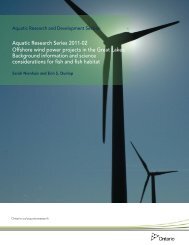(Castanea dentata) in Ontario - Ministry of Natural Resources ...
(Castanea dentata) in Ontario - Ministry of Natural Resources ...
(Castanea dentata) in Ontario - Ministry of Natural Resources ...
You also want an ePaper? Increase the reach of your titles
YUMPU automatically turns print PDFs into web optimized ePapers that Google loves.
Recovery Strategy for the American Chestnut <strong>in</strong> <strong>Ontario</strong><br />
The distribution <strong>of</strong> American Chestnut has been affected by four important events<br />
dur<strong>in</strong>g the past several thousand years. These events <strong>in</strong>clude: (1) a post-glacial<br />
migration from south to north; (2) clear<strong>in</strong>g <strong>of</strong> forests for farm<strong>in</strong>g; (3) commercial logg<strong>in</strong>g;<br />
and (4) <strong>in</strong>troduction <strong>of</strong> chestnut blight to North America (Hill 1994). Follow<strong>in</strong>g the most<br />
recent glacial retreat, this species migrated north. American Chestnut was considered a<br />
slowly dispers<strong>in</strong>g species because evidence <strong>of</strong> it did not appear <strong>in</strong> New England until<br />
2,000 years ago. Whereas Eastern White P<strong>in</strong>e (P<strong>in</strong>us strobus), American Beech<br />
(Fagus grandifolia), crab apples and elms reached New England 9,000, 7,000 and<br />
4,000 years ago, respectively. However, others believe that chestnut was present <strong>in</strong><br />
New England <strong>in</strong> low numbers up to 4,500 years ago (Paillet 1994).<br />
Clear<strong>in</strong>g and logg<strong>in</strong>g reduced much <strong>of</strong> the eastern deciduous forest to only scattered<br />
remnants <strong>of</strong> virg<strong>in</strong> forest by the time Cryphonectria parasitica, the cause <strong>of</strong> chestnut<br />
blight, was <strong>in</strong>troduced to North America <strong>in</strong> the early 1900s.<br />
American Chestnut is considered ‘apparently secure’ with a global conservation status<br />
rank <strong>of</strong> G4. While young shoots <strong>of</strong> this species are widespread and abundant <strong>in</strong> the<br />
United States, it now seldom reaches reproductive maturity due to the presence <strong>of</strong><br />
chestnut blight. Presumably there are millions <strong>of</strong> American Chestnut trees surviv<strong>in</strong>g as<br />
stumps that produce shoots, but large mature trees are extremely rare and are <strong>of</strong>ten<br />
isolated or cultivated far from the species' natural range (Table 1). The conservation<br />
status <strong>of</strong> American Chestnut <strong>in</strong> Canada and <strong>Ontario</strong> is ranked N3 (vulnerable) and S2<br />
(imperilled), respectively (NatureServe, 2009).<br />
Table 1. Conservation Status Rank<strong>in</strong>gs for American Chestnut (NatureServe, 2009)<br />
Level<br />
Conservation<br />
Status<br />
Level<br />
Global G4 USA<br />
Canada N3 Michigan S1S2<br />
<strong>Ontario</strong> S2 Mississippi S1<br />
USA N4 Missouri SNR<br />
Alabama SNR New Hampshire SNR<br />
Connecticut SNR New Jersey S4<br />
Delaware SH New York S5<br />
District <strong>of</strong><br />
Columbia S1S2 North Carol<strong>in</strong>a S4<br />
Florida SX Ohio S3<br />
Georgia S3 Pennsylvania S5<br />
Ill<strong>in</strong>ois SX Rhode Island SNR<br />
Indiana S3 South Carol<strong>in</strong>a SNR<br />
Iowa SNA Tennessee S2S3<br />
Kentucky S1? Vermont SNR<br />
Ma<strong>in</strong>e S4 Virg<strong>in</strong>ia S4<br />
Maryland S2S3 West Virg<strong>in</strong>ia S4<br />
Massachusetts SNR Wiscons<strong>in</strong> SNR<br />
Conservation<br />
Status<br />
5
















